
St. Ambrose Cathedral is a historic building located in downtown Des Moines, Iowa, United States. It serves as a parish church and as the seat of the Diocese of Des Moines in the Catholic Church. The cathedral, along with the adjoining rectory, was listed on the National Register of Historic Places in 1979.
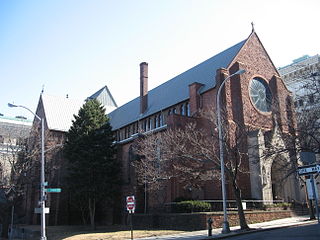
The Cathedral of All Saints, Albany, New York, is located on Elk Street in central Albany, New York, United States. It is the central church of the Episcopal Diocese of Albany and the seat of the Episcopal Bishop of Albany. Built in the 1880s in the Gothic style and designed by Robert W. Gibson, it was listed on the National Register of Historic Places in 1974. Previously it had been recognized as a contributing property to the Lafayette Park Historic District, listed on the Register in 1970.
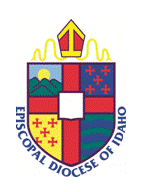
The Episcopal Diocese of Idaho is the diocese of the Episcopal Church in the United States of America, with jurisdiction over Idaho south of the Salmon River, and one congregation in western Wyoming. Located in Province 8, its cathedral is St. Michael's in Boise, as are the diocesan offices.
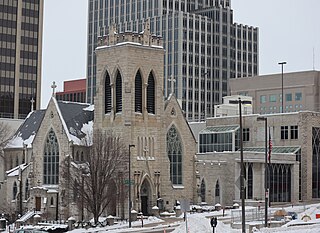
Trinity Cathedral is located in Downtown Omaha, Nebraska. Nebraska's first Episcopal parish, Trinity was established in 1856, and became the state's first Episcopal cathedral in 1872. Designed by noted English architect Henry G. Harrison in 1880, the cathedral was consecrated on November 15, 1883. It was added to the National Register of Historic Places in 1974. Today Trinity Cathedral is considered one of the most beautiful churches in Omaha.

John Everett Tourtellotte was a prominent western American architect, best known for his projects in Idaho. His work in Boise included the Idaho State Capitol, the Boise City National Bank, the Carnegie Library, and numerous other buildings for schools, universities, churches, and government institutions. From 1922 to 1930, he worked in Portland, Oregon.
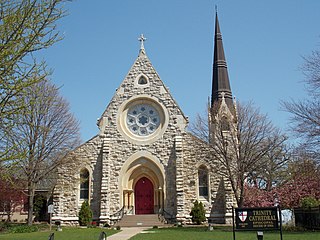
Trinity Episcopal Cathedral, formerly known as Grace Cathedral, is the historic cathedral in the Diocese of Iowa. The cathedral is located on the bluff overlooking Downtown Davenport, Iowa, United States. Completed in 1873, Trinity is one of the oldest cathedrals in the Episcopal Church in the United States. It was individually listed on the National Register of Historic Places in 1974. In 1983 the cathedral was included as a contributing property in the College Square Historic District, which is also listed on the National Register.

St. Paul's Episcopal Cathedral, is located in downtown Des Moines, Iowa, United States. It is the cathedral church of the Episcopal Diocese of Iowa. The building was listed on the National Register of Historic Places as St. Paul's Episcopal Church.

St. John's Episcopal Church is a parish church in the Episcopal Diocese of Iowa. It is located in Keokuk, Iowa, United States. It was listed, together with the parish hall, on the National Register of Historic Places in 1989.

Trinity Episcopal Church is a parish church in the Diocese of Iowa. The church is located in Muscatine, Iowa, United States. It was individually listed on the National Register of Historic Places in 1974. In 2006 it was included as a contributing property in the Downtown Commercial Historic District.
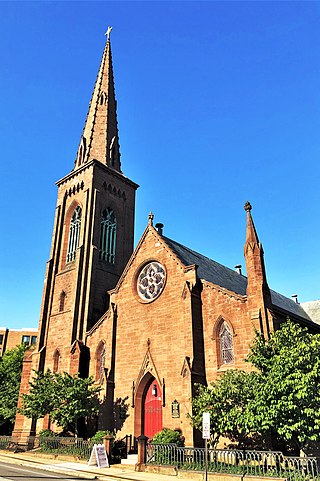
St. James Episcopal Church at 76 Federal Street at the corner of Huntington Street in New London, Connecticut is a historic church in the Episcopal Diocese of Connecticut. The congregation was founded in 1725, and the current church – the congregation's third – was built from 1847 to 1850 to designs in the Gothic Revival style by Richard Upjohn.
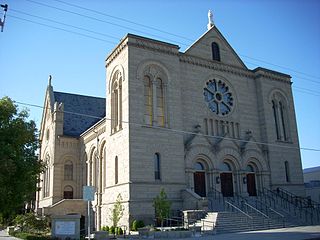
The Cathedral of St. John the Evangelist, also known simply as St. John's Cathedral, is a Catholic cathedral and parish church in the western United States, located in Boise, Idaho. The seat of the Diocese of Boise, the church building was individually listed on the National Register of Historic Places in 1978. It was included as a contributing property of the St. John's Cathedral Block when the rest of the parish buildings on Block 90 were added to the National Register in 1982. That same year, the parish buildings were included as a contributing property in the Fort Street Historic District.
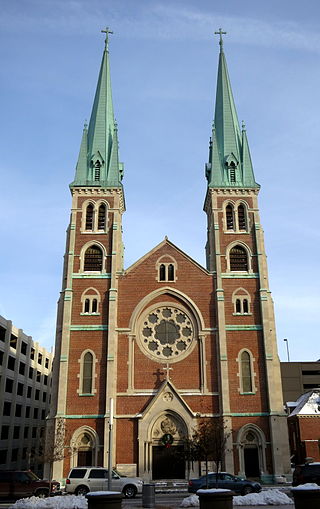
Saint John the Evangelist Catholic Church is a Roman Catholic parish of the Archdiocese of Indianapolis in Indianapolis, Indiana, United States. The parish's origins date to 1837, when it was first named Holy Cross parish. In 1850 it was renamed Saint John the Evangelist parish, and is the oldest Catholic parish in the city and in Marion County, Indiana. Considered the mother of the Catholic parishes in Indianapolis, it played an important role in development of the Catholic Church in the city. Saint John's Church served as the pro-cathedral of the diocese from 1878 until 1906; its rectory served as the bishop's residence and chancery from 1878 until 1892. In 1900 the church served as the site of first episcopal consecration held in Indianapolis.

Christ Cathedral is the cathedral church for the Episcopal Diocese of Western Kansas. It is located in Salina, Kansas, United States, and has been listed on the National Register of Historic Places since 2010.

St. Mark's Pro-Cathedral is an Episcopal Church building located in Hastings, Nebraska, United States. It has been listed on the National Register of Historic Places since 1987. In 2020, it reported 247 members, average attendance of 64, and $120,307 in plate and pledge financial support.

Trinity Episcopal Cathedral is an historic church building at 310 West 17th Street in Little Rock, Arkansas, United States. It is the seat of the Diocese of Arkansas and is listed on the National Register of Historic Places.

St. Matthew's Cathedral is an Episcopal cathedral located in Laramie, Wyoming, United States. It is the seat of the Diocese of Wyoming. The cathedral is a contributing property in the St. Matthew's Cathedral Close, a historic district listed on the National Register of Historic Places.

The Cathedral Church of St. Peter is an Episcopal cathedral in St. Petersburg, Florida, United States. It is the seat of the Diocese of Southwest Florida. In 2004 it was included as a contributing property in the Downtown St. Petersburg Historic District on the National Register of Historic Places.

Bishop Funsten House, also known as The Bishops' House, Old Bishops' House, and Bishop Rhea Center, is a 2+1⁄2-story Queen Anne style clergy house constructed in 1889 in Boise, Idaho, USA, that served as the rectory for St. Michael's Church and later St. Michael's Cathedral until 1960. The house was renovated and expanded during a 1900 remodel by architect John E. Tourtellotte.

Bishop Daniel S. Tuttle House is a nonresidential building adjacent to St. Michael's Episcopal Cathedral in Boise, Idaho. The building was designed by local architects Wayland & Fennell and constructed in 1907 under the direction of Bishop Funsten of the Episcopal Diocese of Idaho, and the building commemorates the work of Daniel S. Tuttle, first bishop of Idaho.

The St. Mary's Episcopal Church, on 1st St. in Emmett, Idaho, was listed on the National Register of Historic Places in 1980.






















